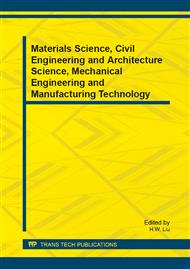[1]
Edward Thomas and Michael Watson. Charging of silica particles in an argon dusty plasma. [J]. Phys. Plasmas, 2000 (7) 3194-3198.
DOI: 10.1063/1.874184
Google Scholar
[2]
Giovanni Lapenta. Dipole Moments on dust particles immersed in anisotropic plasmas. [J]. Phys. Rev. Lett., 1995 (75) 4409.
DOI: 10.1103/physrevlett.75.4409
Google Scholar
[3]
Hubertus M. Thomas and Gregor E. Morfill. Melting dynamics of a plasma crystal [J]. Nature (London), 1996 (379) 806-809.
DOI: 10.1038/379806a0
Google Scholar
[4]
J. H. Chu and Lin I. Direct observation of coulomb crystals and liquids in strongly coupled rf dusty plasmas. [J] Phys. Rev. Lett. A, 1994 (72) 4009-4012.
DOI: 10.1103/physrevlett.72.4009
Google Scholar
[5]
R. Singh and M. P. Bora. Electron-drift ion-acoustic mode in a dusty plasma with collisional effects. [J] Phys. Plasmas, 1999 (7) 2335-2310.
DOI: 10.1063/1.874069
Google Scholar
[6]
Xue Yang, Cong Bo Liu, Yang Yang et al. Existence and damping of dust acoustic solitary waves in a bounded geometry. [J]. Phys. Rev. E, 2013 (87) 063101.
DOI: 10.1103/physreve.91.069903
Google Scholar
[7]
V. A. Schweigert, I. V. Schweigert, A. Melzer et al. Plasma crystal melting: a nonequilibrium phase transition [J] Phys. Rev. Lett., 1998 (80) 5345-5348.
DOI: 10.1103/physrevlett.80.5345
Google Scholar
[8]
Osamu Ishihara and Sergey V. Vladimirov. Wake potential of a dust grain in a plasma with ion flow [J] Phys. Plasmas, 1997 (4) 69.
DOI: 10.1063/1.872112
Google Scholar
[9]
S. V. Vladimirov and M. Nambu. Attraction of charged particulates in plasmas with finite flows. [J]. Phys. Rev. E, 1995 (52) R2172-R2174.
DOI: 10.1103/physreve.52.r2172
Google Scholar
[10]
Giovanni Lapenta. Linear theory of plasma wakes [J]. Phys. Rev. E, 2000 (62) 1175-1181.
DOI: 10.1103/physreve.62.1175
Google Scholar
[11]
Lu-Jing Hou, You-Nian Wang and Z. L. Miskovic. Interaction potential among dust grains in a plasma with ion flow [J] Phys. Rev. E, 2001 (64) 046406.
Google Scholar


